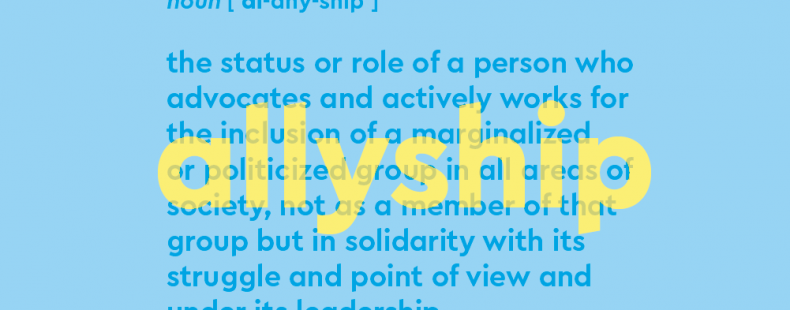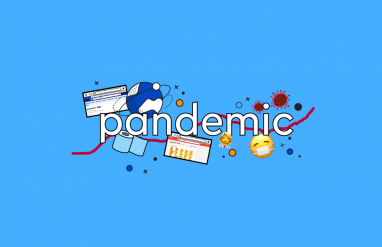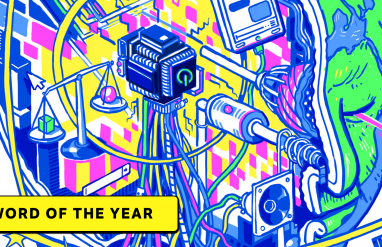2021 was a year defined by the many ongoing impacts of the pandemic and the polarization of 2020—and the various ways we continue to grapple with them.
The vastness of such a year could never be fully summarized with a single word. But there is one word that’s intertwined with so many of the things we’ve experienced in 2021: allyship, our 2021 Word of the Year.
allyship (noun): the status or role of a person who advocates and actively works for the inclusion of a marginalized or politicized group in all areas of society, not as a member of that group but in solidarity with its struggle and point of view and under its leadership.
As our Word of the Year for 2021, allyship carries a special distinction this year: It marks the first time we’ve chosen a word that’s new to our dictionary as our Word of the Year.
Our addition of the word allyship to our dictionary in 2021—not to mention our decision to elevate it as our top word for the year—captures important ways the word continues to evolve in our language and reflects its increased prominence in our discourse.
Allyship acts as a powerful prism through which to view the defining events and experiences of 2021—and, crucially, how the public processed them. It also serves as a compelling throughline for much of our lexicographical, editorial, and educational work across Dictionary.com and Thesaurus.com this year.
And while we must acknowledge that efforts at allyship are all too often insufficient and imperfect, the word nonetheless stands out for its role in the path out of the continued crises of 2020 for a better 2022.
Other words in our Word of the Year shortlist include critical race theory, burnout, and vaccine, all of which speak to important aspects of 2021 in their own distinct ways.
Allyship in the dictionary, discourse, and data
The word allyship combines the noun ally, “a person who advocates for or supports a marginalized or politicized group but is not a member of the group,” and –ship, a noun-forming suffix here denoting “status, condition.”
This specific sense of the word ally is, notably, one we also updated this year. Developing out of the word’s general meaning of “supporter,” the application of ally in contexts of social justice is first evidenced as early as the 1940s in an article by Albert W. Hamilton on “allies on the front of racial justice” for Black people. The article, notably, features the term white allies, which has proliferated ever since. Another now-common term, straight allies—non-LGBTQ+ supporters of the LGBTQ+ community—dates back to at least the 1970s.
📚 Did you know? While the word allyship dates back to the mid-1800s, the word ally itself is much older in the English language. It’s first recorded around 1250–1300, ultimately coming into French from the Latin alligāre, “to bind together, combine, unite,” which is in turn based on ligāre, “to bind.” This Latin verb is the source of many other English words, including alloy, league, ligament, obligation, religion, and rely.
While newly added to our dictionary this year, allyship is, of course, not a new word in the English language. It’s first attested around 1850 in a broader sense of “the relationship or status of persons, groups, or nations associating and cooperating with one another for a common cause.” Its primary meaning today—when a person who is not a member of a marginalized group works for its inclusion in society—spread in the 1990s.
But use of the word allyship skyrocketed in the past 15 years. In fact, since 2011, frequency of the word, according to our data analyses from various corpora (big, searchable collections of texts), has surged an average of over 700%, including a steep rise in 2020 that continued into 2021. The word ally itself landed within the top 850 of the many thousands of search terms that led people to Dictionary.com this year. What’s more, the top related search for allyship in 2021 is definitional in nature: what is allyship, which underscores the timeliness and relevance of our adding allyship this year.
Allyship at work, school, and home
Topics people searched in conjunction with allyship in 2021 also reveal how the word brings together themes that defined many of our work, school, and home lives over this year—including new and newly prominent vocabulary that we used to talk about them.
One of these searches was workplace. Indeed, as the country continued to reckon with racism in 2021, many businesses and organizations began efforts to promote diversity, equity, and inclusion, or DEI for short. These efforts extended into the classroom, where critical race theory (CRT), both as a term and topic, became a defining flashpoint in 2021. Work and school were also defined by COVID-19 vaccines—as well as antivax opposition to them and the disease’s Delta, Omicron, and other named variants.
We added the word allyship this year to document its specific sense that has become more prevalent in recent years. But the word continues to evolve:
In 2021, allyship was increasingly discussed in relation to historically marginalized groups, especially Black and LGBTQ+ communities. There was also noticeable discussion of engaging in allyship for other specific groups: for parents balancing work and childcare during school shutdowns, especially mothers taking on the bulk of caregiving. For healthcare workers, teachers, flight attendants, and retail and service industry workers. For all of the people disproportionately burdened by a pandemic that has claimed over 5 million lives—and counting, even as many of us try to get back to some kind of normal.
Shows of support and advocacy for these groups in 2021 point to ways in which the term allyship is giving name to ever more nuanced ideas of social justice and is increasingly being extended to contexts of support outside of racial, gender, and sexual identity, such as disability and economic status.
Allyship in news and culture
The word allyship also brings together many of the defining new stories of 2021: anti-Asian racism; the Chauvin and Rittenhouse trials; Britney Spears’s conservatorship; Simone Biles’s twisties and the mental health of athletes; the Great Resignation; the US withdrawal from Afghanistan and its impacts, including on the country’s women and girls as well as all who served and died in the war; media coverage of violent crimes and the phenomenon known as “missing white woman syndrome”; and that collective, pervasive feeling of burnout, all amid an unrelenting climate emergency.
These events were notable not only in their own right, of course, but also because of the ways we largely reacted to and discussed them through the lens of who gets a voice, who deserves empathy, and who and what is valued. This was a lens of allyship.
According to corpus data, the word that, far and away, most commonly precedes allyship is performative. The three next most frequent collocations are true, white, and real. Despite the best intentions of societal efforts to foster allyship, use of the term allyship is frequently concerned about how such efforts often fall short and what it means to be an authentic ally.
📝What’s performative allyship?
In the context of allyship, the word performative is often used in contrast with what’s considered real or true allyship. Describing people’s actions as performative suggests that they are simply “playing the part” of being an ally instead of actually supporting the people they claim to—often by centering themselves in the situation.
In this sense, allyship is often considered a status that must be continuously earned—not one that’s simply declared by oneself and worn like a merit badge. In other words, allyship can be understood as an ongoing journey, not a final destination. Not unlike a dictionary: always updating, never a finished product.
On the other side of the spectrum, the use of words like allyship is sometimes criticized as “woke for the sake of being woke”—often as a way of dismissing the very idea that inequality exists among different groups.
On the other side of this lens, on the other side of allyship, is the division that came to a disturbing and deadly head in the event that opened 2021: the attack on the US Capitol on January 6. It was a defining moment not only for politics this year, but also for the history of our democracy. The attack sent searches for insurrection, coup, sedition, and related words to some of the highest-trending levels on Dictionary.com all year.
Allyship across Dictionary.com
The word allyship also brings together much of the lexicographical and educational work we did across Dictionary.com in 2021.
This year, we continued updating our dictionary to better document and describe the changing language of identity and justice in society. Significant areas we addressed were:
- Accessibility language: Examples include new entries for screen reader, alt text, and various distinct types of captioning.
- DEI topics and terms: Examples include entries for DEI, JEDI, CRT, UBI, and minoritize.
- Disability language: Examples include extensive notes at special, disability, and disabled discussing person-first vs. identity-first language for disabilities, and the preference of straightforward disabled or with a disability over older terms (handicapped) and overly euphemistic language (special, challenged).
- Homelessness: Examples include new entries for unhoused and unsheltered and replacing most descriptions of people as homeless with these new terms or with experiencing homelessness.
- Identity language: Examples include new entries for AAPI and BIPOC, revising entries to capitalize Indigenous when referring to people, and replacing the noun slave with enslaved person.
- Mental health: Examples include new entries for content warning and trigger warning.
- Minoritized religions: Examples include revisions to Voodoo and related entries.
- Nonnative speakers: Examples include translanguaging, which is increasingly preferred to code-switching.
Altogether, these updates touched hundreds of entries. Our lexicographers also updated our thesaurus to include scores of nonbinary pronouns, such as xe and zie.
Read more about many of these changes, along with ongoing COVID, tech, pop culture, and other updates to our dictionary, in our spring and summer announcements.
Supporting these updates was an array of editorial content providing in-depth context on these often confusing—and challenging—areas of language change.
This content—amounting to over 60 articles—spanned defining identity terms and DEI topics (e.g., CODA, cultural competence) to providing more inclusive coverage of important occasions across diverse peoples and cultures (e.g., BIPOC Mental Health Month, International Transgender Day of Remembrance, Onam, Installation of Guru Granth Sahib) and extensive explainers on some of the most pressing topics of language and identity today. Some highlights of the latter include:
- The Language Of Ageism: Understanding How We Talk About Older People
- The Evolving Language Around The Autism Spectrum: What You Need To Know
- How To Talk About Mental Health: Do’s, Don’ts, And Words To Know
- Understanding The Caribbean: The Countries, People, And Words That Come From The Region
- Understanding Native American Heritage: The Tribes, Languages, And Culture
- Indigenous Peoples’ Day, Columbus Day, And The Language Of Indigenous Identities
- How To Use Gender-Neutral Language To Promote Inclusivity
Allyship in education
This year at Dictionary.com, we’ve been committed more than ever before to becoming an education ally. From building out the features of Grammar Coach™ and the Dictionary Academy™ to bringing the learning-management system Skillo into our company, we continue to expand our offerings as a dictionary and thesaurus into more robust educational products to meet the real needs of teachers and learners in a variety of learning environments.
Allyship into the future
Finally, allyship has the power to bring us all together. In trying and divided times, the word allyship sounds a much-needed note of hope, optimism, and possibility for the future—hopefully a future in which the word is not just given lip service, but lived out.
Here’s to hoping we can all get allied around that.














